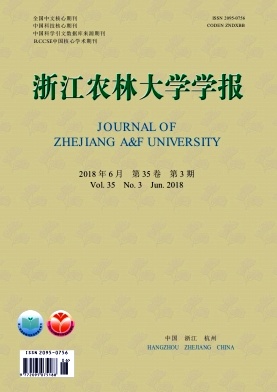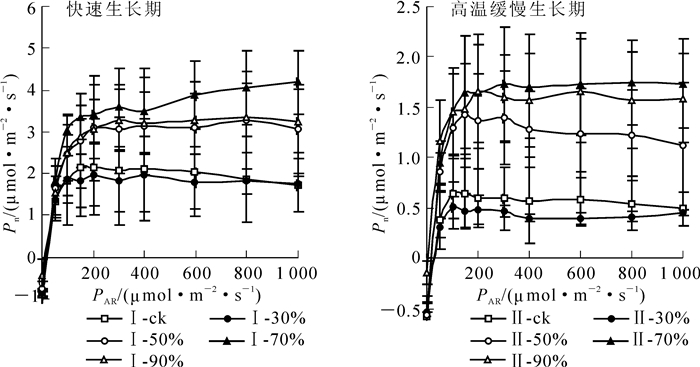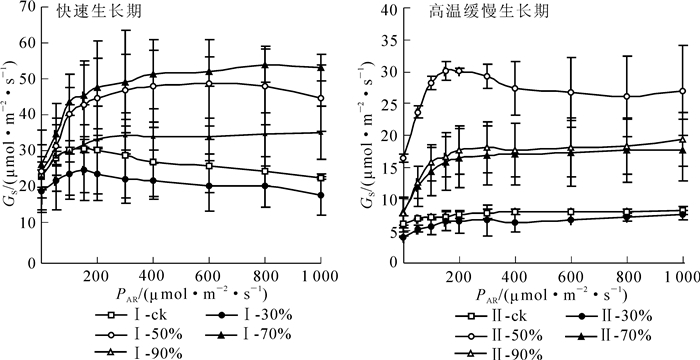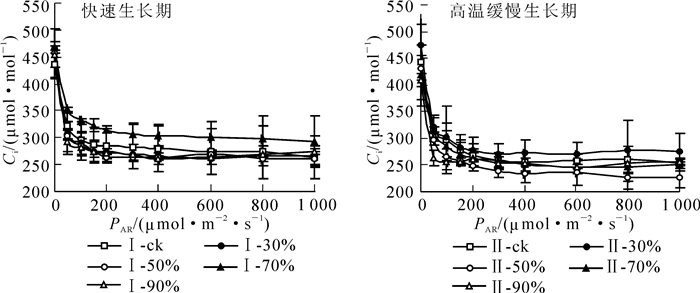-
三叶青Tetrastigma hemsleyanum是葡萄科Vitaceae崖爬藤属Tetrastigma的一种珍稀中草药[1],具有抗炎、镇痛等作用[2],临床上常用来抑制结肠癌[3]、食管癌[4]、肺癌[5-6]等多种肿瘤细胞的增殖和迁移。因其药理作用明显,致使采挖量逐年增加,林下野生三叶青濒临灭绝。近年来,为满足医疗需求,人工栽培面积不断扩大。三叶青在全光照下生长不良或死亡,探寻其适宜生长的光照条件势在必行。在药用植物生长过程中,光强影响其光合作用,进而影响其质量和产量[7]。万小燕[8]对3种药用植物进行了遮光处理,发现遮光影响凉粉草Mesona chinensis形态特征与光合性能,适当遮光可以提高三甲仙草Mesona paruifsota和越南仙草Mesona procumbens的净光合速率。李婷等[9]研究发现:光强过高或过低都会影响穿心莲Andrographis paniculata主要药用成分,随光强增加,穿心莲内酯(AND)量值变低,脱水穿心莲内酯(DDAND)变高。秦健等[10]发现青钱柳Cyclocarya paliurus幼苗随着光强增加其根茎叶生物量及总生物量呈现上升趋势。光照对三叶青的光合特性的影响研究已逐渐起步,刘崟艳等[11]通过不同产地三叶青植株的蒸腾作用与气孔结构研究,发现浙江台州等地的三叶青叶片均在弱光条件下时蒸腾速率最小、净光合速率最高;杨华等[12]研究了不同遮光条件下三叶青的光合特性,认为15%光照下其光合作用较好;钱丽华等[13]和彭昕等[14]发现光周期可调控三叶青叶片愈伤组织的生长及总黄酮量,结果显示12 h·d-1间断性光照最有利于愈伤组织的生长,24 h·d-1光照最有利于黄酮类化合物的累积。本研究着眼于研究不同光强下三叶青的光合指标的特性(净光合速率Pn,最大净光合速率Pmax,光补偿点LCP,光饱和点LSP,表观量子效率AQE,气孔导度Gs,胞间二氧化碳摩尔分数Ci,蒸腾速率Tr等),并进一步讨论其变化及规律,作为筛选三叶青生长的最佳光强条件依据,进行林下仿生栽培,有利于增加三叶青的产量,提高药材品质,满足医药需求。
HTML
-
选用2年生三叶青扦插苗为试验材料,研究于2015年3-8月在浙江农林大学森林培育智能温室和省部共建亚热带森林培育国家重点实验室进行。
三叶青苗进行盆栽,栽培基质按m(泥炭):m(田园土):m(珍珠岩):m(牛粪)=4:4:4:1比例配比制成。遮阳网棚下缓苗1个月后,选取生长健壮、无病虫害、苗高大小近似的三叶青苗20盆,随机分为5组,4盆·组-1,对照组为全光照,采用白色全透光防虫网遮盖,其余4组分别放在遮光度为30%,50%,70%,90%的遮阳棚里(以市售70%的遮阳网为基础,利用剪刀修剪透光空洞的大小及密度,单层或双层覆盖,并用照度计测定透光率,以确保遮光度达到设计要求。测定时间选择晴朗无云的中午12:00,隔半个月测定1次,及时调整误差,确保遮光程度稳定、准确),遮阳网覆盖住棚的顶部及四周。浇水、除草等日常养护工作按照常规种植三叶青方法,定期进行。
指标测定分别选在快速生长期(6月末,即处理后70 d左右)和高温缓慢生长期[15](8月初,即处理后100 d左右)进行。快速生长期的数据标记为Ⅰ-ck, Ⅰ-30%, Ⅰ-50%, Ⅰ-70%和Ⅰ-90%,高温缓慢生长期的数据标记为Ⅱ-ck,Ⅱ-30%,Ⅱ-50%,Ⅱ-70%和Ⅱ-90%。
-
便携式光合系统测定仪(LI-6400XT),紫外分光光度计(UNICO-3802),照度计(TES1339),体积分数为95%的乙醇等。
-
三叶青光合色素测定采用体积分数为95%乙醇浸提法[16]。将采回的样品洗净擦干,去中脉,剪碎,称取0.1 g,加入体积分数为95%乙醇5.0 mL,在黑暗中泡48 h至叶片完全变白即可测定。以体积分数为95%的乙醇作为空白对照,记录波长665,649,470 nm处吸光度。代入相应公式计算相关光合色素质量分数(mg·g-1)。w(叶绿素a)=[13.95D(665)-6.88D(649)]V/1 000m;w(叶绿素b)=[24.96D(649)-7.32D(665)]V/1 000m;R(叶绿素a/b)=w(叶绿素a)/w(叶绿素b);w(总叶绿素)=w(叶绿素a)+w(叶绿素b);w(类胡萝卜素)=[1 000D(470)-2.05w(叶绿素a)-114.80w(叶绿素b)]V/(1 000×245×m)。其中:m为鲜叶质量,V为叶绿素提取液总体积,D(λ)为吸光度。
-
光合测定于晴天上午进行,利用LI-6400XT便携式光合系统测定仪,选配红蓝光源的2 cm × 3 cm标准叶室。设定一系列的光合有效辐射(PAR)梯度:0,50,100,150,200,300,400,600,800,1 000 μmol·m-2·s-1,设定最少稳定时间为2 min,二氧化碳浓度设定为400 μmol·s-1,叶室温度设定为29 ℃,气体流速设定为500 μmol·s-1,相对湿度设定为70%左右。选择不同重复处理下生长健壮的三叶青植株,各株选择中上部大小、颜色相近似的叶片进行测定,重复测定3次·株-1。记录三叶青的净光合速率(Pn),气孔导度(Gs),胞间二氧化碳摩尔分数(Ci)和蒸腾速率(Tr)。
-
采用SPSS 19.0软件对数据进行统计分析,用光合助手(Photosynthesis)软件计算出光饱和点(LSP),光补偿点(LCP),量子效率(AQE),暗呼吸速率(Rd)和最大净光合速率(Pmax),拟合光响应曲线。运用单因素方差分析法(one-way ANOVA)和最小显著差法(LSD)进行方差分析和多重比较(α=0.05)。
1.1. 材料处理
1.2. 仪器与试剂
1.3. 叶片光合色素测定
1.4. 叶片光合参数测定
1.5. 数据处理
-
三叶青光合色素测定结果见表 1。经遮光处理后,三叶青叶绿素a,叶绿素b,总叶绿素和类胡萝卜素的量随着遮光程度的增加呈上升趋势。叶绿素a,叶绿素b,总叶绿素和类胡萝卜素的量在遮光50%以上显著增加,且在遮光90%出现最大值;叶绿素a/b值呈降低趋势,遮光50%以上差异显著(P < 0.05)。分析认为,光合色素的合成受光强影响,其中叶绿素在植物光合作用中具有吸收、传递和转化光能的作用,而类胡萝卜素为光吸收的辅助色素,对植物具有光保护作用。
遮光处理/% 三叶青叶片色素水平 w叶绿素a/(mg·g-1) w叶绿素b/(mg·g-1) w总叶绿素/(mg·g-1) w类胡萝卜素/(mg·g-1) 叶绿素a/b Ⅰ-ck 0.47 ± 0.05 bc 0.07 ± 0.01 c 0.54 ± 0.07 cd 0.15 ± 0.01 cd 7.06 ± 0.39 a Ⅰ-30 0.41 ± 0.04 b 0.06 ± 0.01 c 0.47 ± 0.05 d 0.13 ± 0.01 d 6.95 ± 0.54 a Ⅰ-50 0.54 ± 0.05 c 0.09 ± 0.01 b 0.63 ± 0.06 c 0.17 ± 0.04 c 5.98 ± 0.11 b Ⅰ-70 0.66 ± 0.05 d 0.12 ± 0.01 a 0.77 ± 0.06 b 0.20 ± 0.01 b 5.66 ± 0.28 b Ⅰ-90 0.81 ± 0.03 a 0.13 ± 0.01 a 0.94 ± 0.04 a 0.26 ± 0.005 a 6.27 ± 0.30 b Ⅱ-ck 0.41 ± 0.02 b 0.06 ± 0.02 0.47 ± 0.06 c 0.14 ± 0.02 c 7.49 ± 0.40 a Ⅱ-30 0.37 ± 0.04 b 0.05 ± 0.03 c 0.42 ± 0.04 c 0.12 ± 0.03 c 7.21 ± 0.50 a Ⅱ-50 0.60 ± 0.04 c 0.10 ± 0.03 b 0.70 ± 0.05 b 0.21 ± 0.03 b 5.86 ± 0.12 b Ⅱ-70 0.70 ± 0.04 d 0.13 ± 0.02 b 0.82 ± 0.06 a 0.21 ± 0.02 b 5.55 ± 0.30 b Ⅱ-90 0.84 ± 0.03 a 0.14 ± 0.03 a 0.98 ± 0.04 a 0.27 ± 0.01 a 6.15 ± 0.32 b 说明:不同字母表示在0.05水平上差异显著 Table 1. Effects of different light intensity on photosynthetic pigments content of Tetrastigma hemsleyanum with different light intensity treatments
在高温缓慢生长期,全光照(ck)和遮光30%的叶片色素量有所降低,叶绿素a/b比值增加,其余各组色素的量均上升,叶绿素a/b比值下降。叶绿素a的最大吸收在长波红光区(680 nm),叶绿素b的最大吸收在短波蓝光区(460 nm)。叶绿素a/b变小反映植物对外界短波光吸收量的相对增加, 说明在遮光30%以下三叶青叶片光合系统吸收过量的光能,导致光合色素的反应中心的失活或损害,遭受了强光胁迫,各生物量下降,合成光合色素需要的物质供给减少,因而光合色素总量降低,生长不适应;在遮光50%以上,未产生强光胁迫,生长较适应,也间接证明了三叶青具有较强的耐阴性。
-
如图 1所示:各遮光处理三叶青的光合-光响应曲线变化趋势基本一致。总体而言,当PAR在0~200 μmol·m-2·s-1时,Pn迅速升高;PAR在200~400 μmol·m-2·s-1时,Pn上升速度减缓;当PAR > 600 μmol·m-2·s-1时,遮光50%以上的Pn趋于稳定,而遮光30%和ck的Pn呈现降低趋势。随遮光程度增强,Pn呈现先增后降趋势,遮光50%以上的Pn均高于ck,在遮光70%处理组达到最大值。处于高温缓慢生长期时,各处理下Pn均比快速生长期有所降低。

Figure 1. Net photosynthetic rate (Pn)-light response curves of Tetrastigma hemsleyanum with different light intensity treatments
由表 2可以看出:LSP,AQE和Pmax随着遮光程度增加呈现先上升后降低趋势,均在遮光70%达到最大值;LCP呈现下降趋势,在遮光90%达到最小值,Rd的变化上下波动,但均在遮光70%时达到最大值。与快速生长期相比,高温缓慢生长期相同遮光处理下的LSP,AQE,Rd,Pmax数值均下降,而LCP则呈现上升趋势,与ck相比,LSP,AQE,Rd在50%以上差异显著(P < 0.05)。
遮光处理/% 光合参数 LSP/(μ·mol-2·s-1) LCP/(μ·mol-2·s-1) AQE/(mol·mol-1) Rd/(μ·mol-2·s-1) Pmax/(μ·mol-2·s-1) Ⅰ-ck 97.36 ± 19.23 c 12.67 ± 2.31 ab 0.070 ± 0.020 b 0.88 ± 0.03 b 2.88 ± 1.05 b Ⅰ-30 88.58 ± 14.68 c 14.65 ± 1.16 a 0.060 ± 0.010 b 0.87 ± 0.15 b 2.73 ± 0.73 b Ⅰ-50 224.48 ± 24.94 b 12.66 ± 3.05 ab 0.080 ± 0.030 b 0.82 ± 0.25 ab 3.53 ± 0.83 b Ⅰ-70 340.49 ± 32.11 a 8.66 ± 4.17 bc 0.180 ± 0.070 a 1.20 ± 0.41 b 5.34 ± 1.00 a Ⅰ-90 244.95 ± 33.03 b 6.99 ± 1.73 c 0.050 ± 0.020 b 0.42 ± 0.16 a 3.73 ± 0.89 ab Ⅱ-ck 76.71 ± 3.06 c 26.68 ± 10.27 a 0.030 ± 0.010 b 0.60 ± 0.05 b 1.19 ± 0.34 b Ⅱ-30 66.05 ± 0.01 c 18.68 ± 5.03 ab 0.030 ± 0.006 b 0.57 ± 0.08 b 1.21 ± 0.30 b Ⅱ-50 86.61 ± 23.87 bc 14.66 ± 4.16 bc 0.040 ± 0.002 ab 0.58 ± 0.21 b 1.88 ± 0.68 ab Ⅱ-70 159.28 ± 10.36 a 13.33 ± 4.61 bc 0.060 ± 0.006 a 0.70 ± 0.27 b 2.45 ± 0.71 a Ⅱ-90 105.97 ± 11.22 b 5.34 ± 4.17 c 0.041 ± 0.026 ab 0.17 ± 0.12 a 1.38 ± 0.54 b 说明:不同字母表示在0.05水平上差异显著 Table 2. Characteristic parameters of photosynthetic response curve of Tetrastigma hemsleyanum with different light intensity treatments
-
气孔是植物与外界进行气体交换和蒸腾作用的通道,因此,Gs的大小决定二氧化碳和水进出植物细胞的速率,进而间接影响植物的光合作用和蒸腾速率。由图 2可见:各处理均呈现先快速上升后趋于稳定的趋势,其中,遮光50%~90%处理的Gs均高于遮光30%和全光照,表明可能三叶青在长期的强光胁迫下可导致气孔关闭,故Gs下降。快速生长期的Gs最大值出现在遮光70%(54.33 mmol·m-2·s-1),高温缓慢生长期各处理下Gs在均有所降低,最大值为遮光50%(30.02 mmol·m-2·s-1)。分析认为,夏季的高温及高光强使三叶青生长滞缓,气孔开闭不活跃,各处理Gs均降低。
由图 3可知:当PAR在0~200 μmol·m-2·s-1时,不同遮光处理下三叶青的Ci快速下降,并在之后随光强增加,各处理的Ci处于低水平;不同生育时期的三叶青Ci差异不大。一般而言,Ci大小取决于4个因素:叶片周围空气中的二氧化碳浓度,Gs,叶肉导度(gm)和叶肉细胞的光合活性[18]。当叶片周围空气二氧化碳浓度升高,Gs和gm增大,叶肉细胞的光合活性降低时,Ci会增大;反之,Ci则减小。本研究中,不同遮光处理下三叶青的Ci先快速下降,后保持稳定,与光合响应曲线的变化趋势负相关。随着光照强度的增加,三叶青进行光合作用,二氧化碳快速消耗,因此,Ci降低,Pn快速增加;不同生育时期,三叶青叶片的Ci与Pn变化趋势一致,即都在高温缓慢生长期下降,显示该时期三叶青生长缓慢,Pn较低,对二氧化碳的消耗较少。
图 4显示:随着光照强度的增加,各处理的Tr均出现上升趋势。三叶青属于喜阴药用植物,遮光可减少高光强伤害,并使气孔活跃度增加[19],故Tr随Gs呈现上升趋势。在快速生长期,Tr最大值(0.98 mmol·m-2·s-1)出现在遮光70%处理组,高温缓慢生长期的Tr最大值(0.58 mmol·m-2·s-1)出现在遮光90%处理组,与Gs变化同步,或与盛夏高光强、高温及低空气湿度等因素有关[20]。
2.1. 不同光强处理对三叶青光合色素的影响
2.2. 不同光强处理对三叶青光合-光响应曲线的影响
2.3. 不同光强处理对三叶青Gs,Ci,Tr的影响
-
一般而言,光合色素含量的高低可在一定程度上直接反映植物光合效率的大小,并间接反映植物的生长状况。植物在弱光条件下,为弥补光强不足,常通过增加色素含量以提升自身捕获光能的能力,进而更好地进行有机物的合成和积累;反之,在强光条件下,色素含量会降低,这是植物的一种适应性调节[20]。本研究中,随着遮光程度的上升,三叶青叶绿素a,叶绿素b,总叶绿素和类胡萝卜素的量总体上呈现上升趋势,与大多数研究结果一致[21-22]。在高温缓慢生长期,对照和遮光30%的叶片色素量降低,其余各组色素质量分数上升,说明在遮光30%以下三叶青叶片遭受强光胁迫,生长不适应;在遮光50%及以上,则光强较为适宜,长势良好。
光响应曲线及各光合指标变化是植物光合特性研究的主要内容。三叶青在全光照时净光合速率较低,对强光的利用能力不强,与金莲花Trollius chinensis在全光照下长势较差结果相同[23]。在90%遮光处理下,三叶青叶片的净光合速率低于70%遮光处理,说明此遮光程度过高,三叶青可吸收的光能较少,导致其光合作用能力下降,不利于其生长及生物量积累[24-25]。对重楼Paris polyphylla[26-27]和半夏Pinellia ternata[28]的研究也表明它们在适宜的遮光下生长良好。有研究表明,低光补偿点、高光饱和点的植物对复杂的光环境有更强的适应性[29],且量子效率越高,其耐阴性越强[30]。三叶青在遮光50%以上的光饱和点均显著高于全光照,且光补偿点值较低,说明其光合作用过程中暗反应对同化力最大需求量较高,当外界环境条件为遮光50%以上的弱光环境时,其利用光能利用率良好。其中,遮光70%的光饱和点达到最大值,光补偿点值较低,且量子效率最高,说明遮光70%时三叶青生长最适宜。气孔导度变化直接影响植物蒸腾速率, 间接影响净光合速率[31-32]。本研究结果亦符合该结论,尤其在高温缓慢生长期,强光、高温、低湿等环境条件使气孔活跃度降低,进而对三叶青光合作用及生理活动产生胁迫,致使其生长滞缓。
本研究通过对不同遮光程度和不同生育时期下的三叶青光合生理特性比较研究,明确了其光合生理特性与光强之间的关系,并得出结论,适宜遮光可提高三叶青光合色素质量分数、净光合速率、光饱和点、光补偿点、气孔导度和蒸腾速率,不同生育时期各指标均以遮光70%时最佳,与DAI等[33]结论相近,可为今后人工栽培和林下栽培提供相关理论基础。
-
本研究的试验材料由浙江省台州市黄岩常柳植物科技有限公司提供,为小叶型高产三叶青品系。特此感谢!










 DownLoad:
DownLoad:


